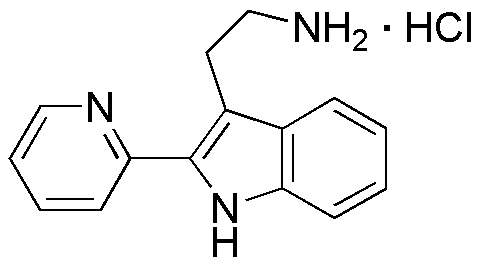2-(2-Pyridin-2-yl-1H-indol-3-yl)ethanamine monohydrochloride is widely utilized in research focused on:
- Pharmaceutical Development: This compound serves as a key intermediate in the synthesis of novel pharmaceuticals, particularly in the development of drugs targeting neurological disorders.
- Biochemical Research: It is used in studies related to receptor binding and enzyme inhibition, helping researchers understand complex biological pathways and interactions.
- Material Science: The compound is explored for its potential in creating advanced materials, such as organic semiconductors, due to its unique electronic properties.
- Diagnostic Applications: It can be employed in the formulation of diagnostic agents, enhancing the detection of specific biomarkers in medical imaging.
- Agrochemical Innovations: Researchers are investigating its use in developing new agrochemicals that improve crop yield and resistance to pests, contributing to sustainable agriculture.
General Information
Properties
Safety and Regulations
Applications
2-(2-Pyridin-2-yl-1H-indol-3-yl)ethanamine monohydrochloride is widely utilized in research focused on:
- Pharmaceutical Development: This compound serves as a key intermediate in the synthesis of novel pharmaceuticals, particularly in the development of drugs targeting neurological disorders.
- Biochemical Research: It is used in studies related to receptor binding and enzyme inhibition, helping researchers understand complex biological pathways and interactions.
- Material Science: The compound is explored for its potential in creating advanced materials, such as organic semiconductors, due to its unique electronic properties.
- Diagnostic Applications: It can be employed in the formulation of diagnostic agents, enhancing the detection of specific biomarkers in medical imaging.
- Agrochemical Innovations: Researchers are investigating its use in developing new agrochemicals that improve crop yield and resistance to pests, contributing to sustainable agriculture.
Documents
Safety Data Sheets (SDS)
The SDS provides comprehensive safety information on handling, storage, and disposal of the product.
Product Specification (PS)
The PS provides a comprehensive breakdown of the product’s properties, including chemical composition, physical state, purity, and storage requirements. It also details acceptable quality ranges and the product's intended applications.
Certificates of Analysis (COA)
Search for Certificates of Analysis (COA) by entering the products Lot Number. Lot and Batch Numbers can be found on a product’s label following the words ‘Lot’ or ‘Batch’.
*Catalog Number
*Lot Number
Certificates Of Origin (COO)
This COO confirms the country where the product was manufactured, and also details the materials and components used in it and whether it is derived from natural, synthetic, or other specific sources. This certificate may be required for customs, trade, and regulatory compliance.
*Catalog Number
*Lot Number
Safety Data Sheets (SDS)
The SDS provides comprehensive safety information on handling, storage, and disposal of the product.
DownloadProduct Specification (PS)
The PS provides a comprehensive breakdown of the product’s properties, including chemical composition, physical state, purity, and storage requirements. It also details acceptable quality ranges and the product's intended applications.
DownloadCertificates of Analysis (COA)
Search for Certificates of Analysis (COA) by entering the products Lot Number. Lot and Batch Numbers can be found on a product’s label following the words ‘Lot’ or ‘Batch’.
*Catalog Number
*Lot Number
Certificates Of Origin (COO)
This COO confirms the country where the product was manufactured, and also details the materials and components used in it and whether it is derived from natural, synthetic, or other specific sources. This certificate may be required for customs, trade, and regulatory compliance.


